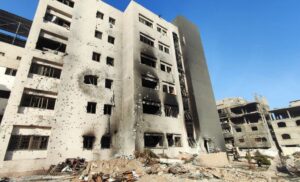The symbol for healthcare was once a mark of a sacred space — one that, according to international humanitarian law, marked out a facility as a site to be protected in war. Now that symbol has instead become a prime target.
The Israeli army justifies its attacks on healthcare by alleging that Hamas is operating from hospitals. However, in order for a hospital to lose its protected status under international law, it would need to be used to commit “acts harmful to the enemy.” Hamas fighters sauntering through a hospital to get a hostage treated hardly constitutes an act harmful to the enemy, nor does the strange presence of guns behind an MRI machine (surely the worst place to store a metal object), as they could easily fall under the provision of “small arms and ammunition taken from the wounded and sick…not yet handed to the proper service.” If such arms were to be found in a hospital, they would not deprive the hospital of its protected status under international law.
The bar for losing protected status is set very high. The International Committee of the Red Cross states that, “In case of doubt as to whether medical units of establishments are used to commit an ‘act harmful to the enemy’, they should be presumed not to be so used.” The Israeli army attacked all 36 hospitals in Gaza, such that there are no longer any that are fully functional. Not even one of those hospitals had been shown to meet the criteria needed to lose its protected status, let alone all 36. Moreover, even on the rare occasion that a hospital loses its protected status, the military would still need to protect patients and staff, make contingency plans to address the disruption to healthcare, and help restore healthcare services after the attack.
In light of the scale of human suffering during World War II, the Geneva Conventions of 1949 were created to provide better protection to civilians. Article 19 of the Geneva Conventions states that medical establishments, staff, and patients should not be attacked. The Conventions became a cornerstone in international humanitarian law and medical ethics, but recent conflicts show how easy it is for states that flout them to go unpunished.
In Gaza, it is not that hospitals have suddenly changed their mission such that they can now be used as weapons of war. Rather, their mission to save lives is precisely what renders them so vulnerable in conflicts when the aim is to kill as many people as possible. This vulnerability is being exploited in Gaza to the greatest effect and means that no one, not even an individual seeking medical care, is safe.
And the policy of Israel’s targeting of healthcare is not limited to Gaza. The WHO documented 187 attacks on healthcare in the West Bank in 2022 alone. In the current Gaza genocide, the healthcare system has been decimated by unrelenting attacks. Medical equipment has been deliberately destroyed, and unless the ECG and MRI machines were threatening IDF soldiers, it is likely that their destruction was an act of sabotage, not self-defense. Unless Gazan embryos have superpowers, we can probably conclude that the destruction of 4,000 embryos at an IVF clinic in Gaza was not self-defense either.
It is not just buildings, equipment, ambulances, and embryos, but also medical staff and patients who have been targeted. For instance, in the massacre at al-Shifa Hospital, most of the medical staff were either arrested or murdered. This also happened during the war in Syria, with 601 attacks on over 350 healthcare facilities in 11 years of war. Yet this is not the same scale as we have seen in Gaza.

